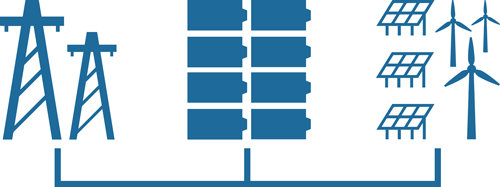With increasing amounts of intermittent energy sources joining New England’s resource mix, the need to balance a more complex electricity grid has emerged. For example, with solar and wind now dominating the queue of proposed energy projects in New England, the region will need flexible resources to meet fluctuations in supply and demand that occur throughout the day. In the past decade, emerging technologies, such as batteries, have brought the region efficient energy storage in smaller, modular packages to help balance intermittency.
Batteries can help store surplus energy from renewable resources that might otherwise be wasted. That stored energy can be used later, helping to serve electrical demand at night or on a windless, cloudy day.
ISO New England has laid a strong foundation to support the region’s transition to a smarter, cleaner grid—which includes increasing amounts of battery storage.
Pumped-storage hydropower, which has long been a part of New England's resource mix, illustrates the principles of energy storage—and helps explain how batteries interact with the grid. At a pumped-storage hydro facility, stored energy takes the form of a full reservoir. That stored energy can be dispatched to the grid as electricity at a moment’s notice. Similarly, a fully charged battery contains energy that is available for immediate use. In both cases, once stored energy is depleted, it must be replenished.
Batteries can be measured by their “state of charge”—a measure of how “full” the storage is in real time or how much “room” there is to store energy.

A fully charged battery is like a full reservoir at a pumped-storage hydropower facility.

A battery’s available energy decreases as it injects electricity into the grid—just as a pumped-storage hydropower facility’s amount of stored energy decreases as its water level drops.
Storage resources have two quantities that are important to consider: the power rating and the energy rating. Imagine a battery connected to a string of identical light bulbs.


The ISO’s redesigned Regulation Market went into effect in March 2015, allowing alternative technologies like battery storage to compete in providing regulation services to the wholesale electricity markets as alternative technology regulation resources (ATRRs).
In December 2016, FERC accepted ISO-NE’s proposed market rule changes, enabling energy storage resources to participate in the Day-Ahead and Real-Time wholesale electricity markets while continuing their participation in the Regulation Market. These changes, which went into effect in December 2018, provided greater opportunities and incentives for energy storage to participate in New England’s wholesale electricity markets.
Since the introduction of the Energy Storage Device Project in 2019, market participants with front-of-the-meter batteries became eligible for the Real-Time and Day-Ahead energy markets in addition to the ancillary service markets. Battery projects are also competing in the Forward Capacity Market, with more than 1,800 MW of battery storage securing capacity supply obligations in the most recent Forward Capacity Auction, held in February 2024.
The ISO’s proposal in response to FERC Order No. 2222 could further enhance the way distributed energy resources (DERs) access the wholesale energy, capacity, and ancillary service markets.
The ISO’s compliance proposal will create new possibilities for DERs of all types, including (but not limited to) batteries, as well as emerging technologies such as electric vehicle chargers and grid-responsive water heaters. These resources will serve the region through aggregations capable of participating in New England’s wholesale power markets.
If interconnected to the high-voltage electric transmission system, most batteries can react almost instantly to changes in supply and demand, helping to smooth out fluctuations.
When batteries are connected to the grid in front of the meter, they can function as demand resources; resource owners can choose to draw electricity from the grid if prices are lower, and then sell it back into the ISO’s energy markets when prices are higher.
When located behind the meter and within a utility’s distribution system, batteries can be used to time-shift demand, enabling other energy sources to be used as they become available or are more cost-efficient. For example, solar energy is not produced at night, but energy stored in batteries can help fill that supply gap.
Batteries can also provide backup power for remote areas during distribution system power outages.


As a Regional Transmission Organization (RTO), the ISO coordinates how transmission lines, power plants, and other resources connect to and operate in alignment with New England’s high-voltage transmission system. The ISO’s interconnection process enables new resources to request connection to the region’s transmission grid to supply electricity to New England. Battery storage projects made up about 46% of the proposed generating capacity in the Interconnection Request Queue as of January 2024, compared to 10% in July 2020—and less than 1% in May 2017.
In addition, the New England states have taken steps to support the expansion of battery technology.
Changes to the resource mix and load patterns in New England will reveal further opportunities for energy storage and supply solutions to complement an evolving power system. What is certain is that these solutions, including batteries, are on track to play an important role in New England’s clean energy transition.